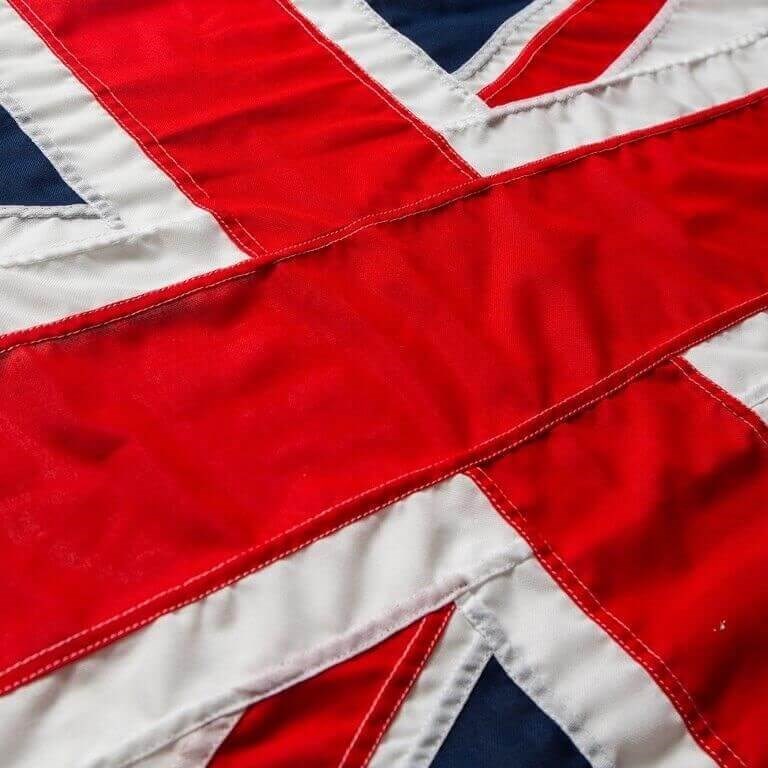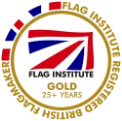Trivia
The national flag flies from the world’s third tallest flagpole in North Korea. The flagpole is at 520 feet tall.
Technical Specifications
| Adopted | 8th September 1948 |
|---|---|
| Proportion | 1:2 |
| Design | A red stripe with a white and blue border. Inside the central stripe is a white disk with red five-pointed star. |

Brief History
One of the first flags flown in Korea in the 1800s was the personal standard of the Joseon dynasty who ruled the Kingdom of Joseon for five centuries. The flag has a red field with peach border with black triangles. Inside the flag is the bagua, collection of eight Taoist symbols called trigrams, and a circular taegeuk symbol.
The flag of the Korean Empire was adopted in 1882 featured a white field with four of non-specified trigrams and a blue and red taegeuk symbol in the centre.
In 1910 Japan took control of Korea and the white field with red sun flag of Japan was adopted. After World War two the Koreans took control again and started an interim government of the People’s Republic of Korea. The Flag of the Korean Empire was readopted. The trigrams on the flag are, from top right to bottom left, water, heaven, earth and fire.
The northern part of Korea was occupied by Soviet forces in 1946 and created the Provisional People’s Committee for North Korea. A design similar to the previous flag was adopted with a modified taegeuk symbol and, from top right to bottom left, the heaven, fire, water and earth Taoist symbols.
In 1948, with support from the Chinese, the Democratic People’s Republic of Korea was born. The flag chosen was a radically different design to the previous ones. It featured a red stripe with a white and blue border. Inside the central stripe is a white disk with a soviet red five-pointed star.
The flag can be displayed both vertically and horizontally. The red star represents communism, red panels represent patriotism, white stripe is unification and culture, with the blue stripe representing unity.

The Flag of the Democratic People’s Republic of Korea (1948 to Present Day)
The Emblem of North Korea
The emblem of North Korea was adopted in 1948 and features the Sup’ung hydroelectric plant in front of the Paektu mountains at the centre surrounded by ears of rice. Above is a red star and bellow is a red banner stating “THE DEMOCRATIC PEOPLE’S REPUBLIC OF KOREA”.
The Military Flags of North Korea
The Flag of the Korean People’s Army is a gold-fringed national flag with the national emblem replacing the star. The Ground Force flag removed the national emblem and features darker blue stripes and the emblem for the Korean People’s Army in the centre.
The Navy flag is white with a large blue stripe and two thin blue stripes with the Korean People’s Army emblem at the centre.
The Air Force flag features the People’s Army emblem at the centre on a sky blue field with a thick dark stripe in the lower portion with three thinner dark blue stripes above.
The Flag of the Workers’ Party of Korea
The Flag of the Workers’ Party of Korea is the flag of the ruling party of North Korea. It features a red field with a golden hammer, sickle and calligraphy brush. The flag can also be displayed vertically.
The Unification Flag of North and South Korea
The Unification Flag of North and South Korea is an unofficial 2:3 flag that is usually flown when North and South Korea are together in sporting events. It features a white background with a light blue map of Korea.
The Flag of the Sinuiju Special Administrative Region
The Flag of the SinuiJu Special Administrative Region was established in 2002 and features a turquoise field with white flower in the centre.
The Historical Emblems of North Korea
Here are some examples of the historical emblems of North Korea.





